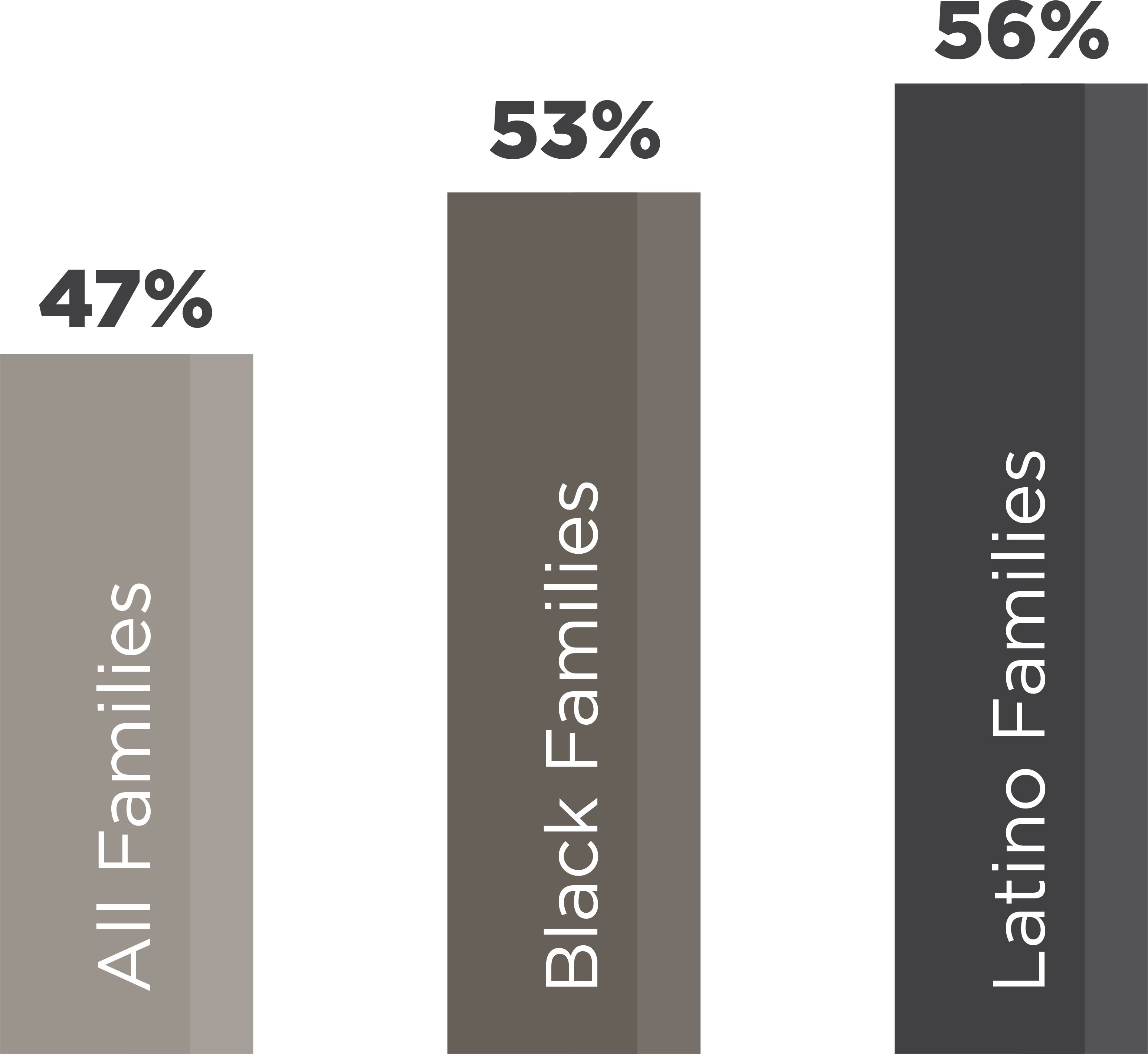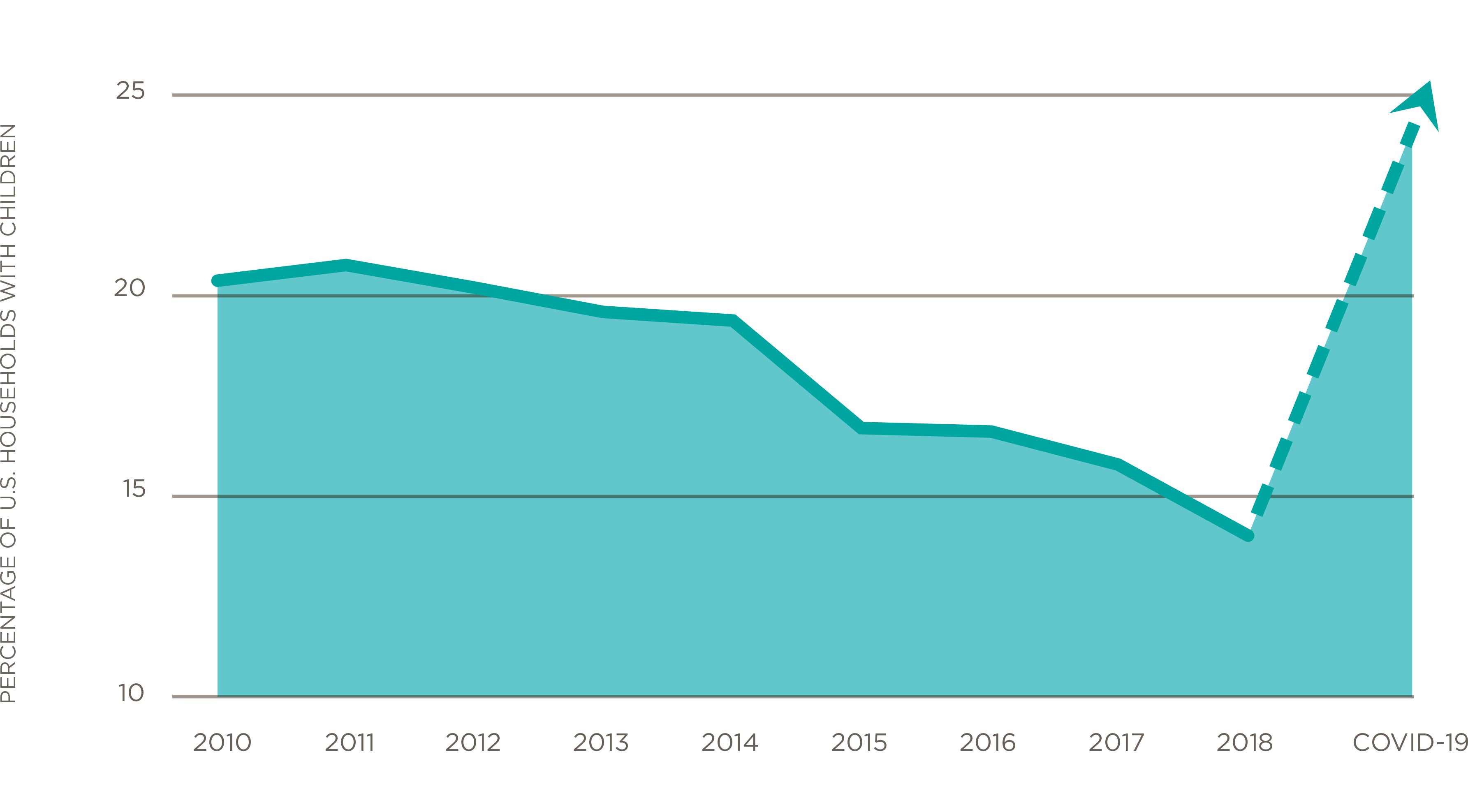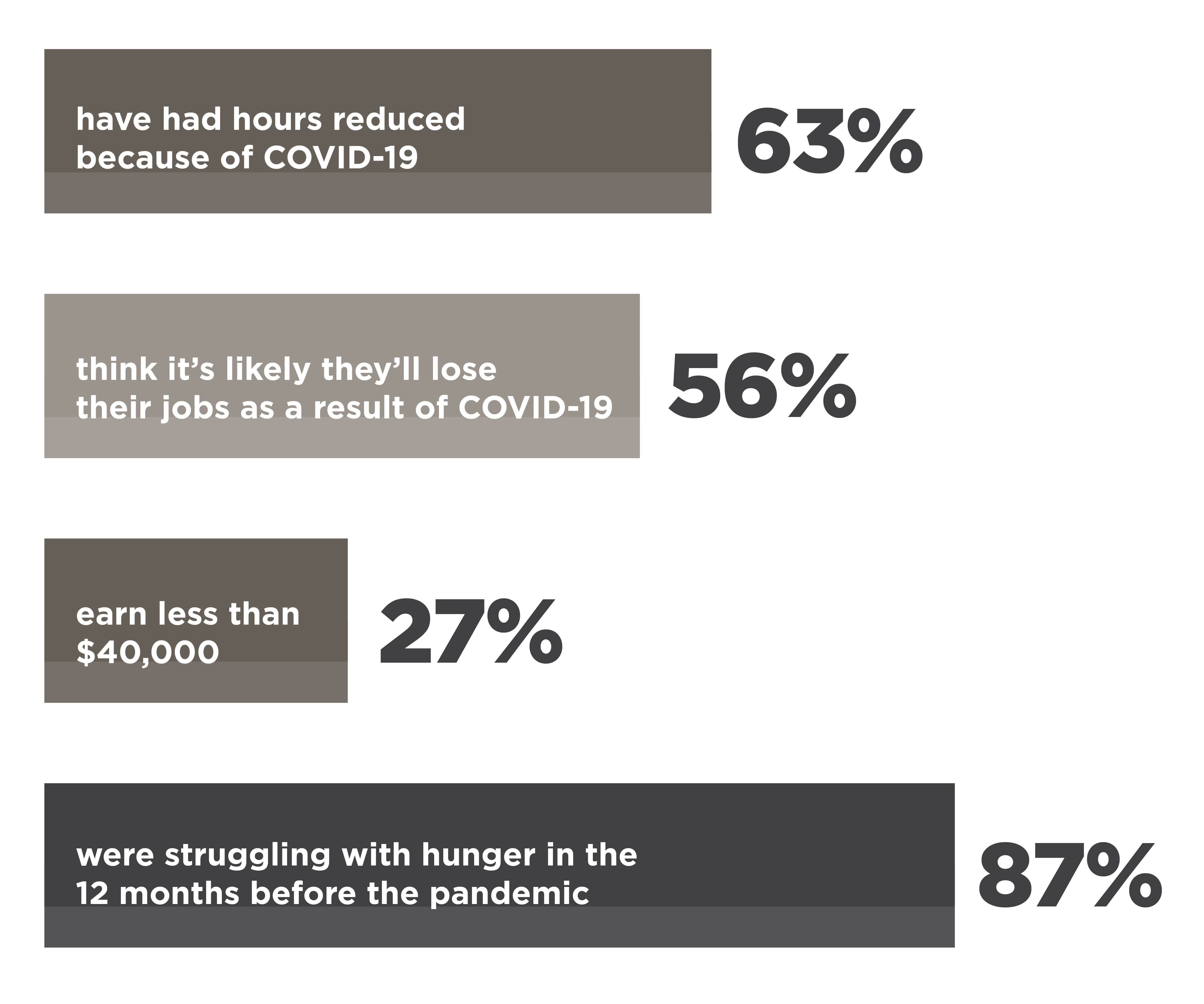Before the pandemic, summer was already a hard time for families struggling to feed their kids, with schools closed and school meals gone. This year, schools closed in March, leaving many children without reliable daily meals for months on end. In the wake of COVID-19, more American families are waiting in line at food banks and rationing meals for their kids.
This report gives new insight into the pandemic’s impact on children - how they’re coping and what new sacrifices their families are forced to make. The story is a bleak one - even more so for Black and Latino children.
But there is a thin ray of light. More Americans are newly aware of just how many families were living on the edge before the pandemic - and how many children struggle with hunger. And more Americans are willing to invest in a stronger safety net to feed them. It’s a safety net we must strengthen, for meals they cannot afford to miss.
More Kids Facing Hunger
“When you're in a tough situation like this you basically go into survival mode and go back to the basics. How am I going to keep a roof over my son's head and how am I going to keep food on our table?”
- Kyle, father, New York
During the COVID-19 pandemic, 47% of American families are living with hunger. The numbers are worse among Black families (53%) and Latino families (56%).

Over the past decade we made real progress in the fight against childhood hunger. But COVID-19 has set us back. Some organizations have reported data showing 1 in 4 households with children facing hunger and our new research shows an even higher figure. This represents a huge leap from the 1 in 7 reported in September 2019.
So drastic a change in such a short time period shows that many families were one lost job or stalled school meal program away from hunger.
CHILDHOOD HUNGER SINCE 2010 AND THE COVID-19 SPIKE

During the pandemic, many struggling families have been forced to make new sacrifices to get by.
39%
are skipping certain bills more often in order to make sure they have food.
“During this coronavirus, I've had zero income, I'm definitely going to eat and make sure my kid can eat, over paying the rent. Yeah, we didn't pay the rent. And that wasn’t easy because they had to evict us, so we would have a couple months before the eviction kicked in. If I had paid the rent, then what?”
- Rebecca, mother, Oregon
51%
of parents are skipping meals or limiting the amount everybody eats more often as a result of the crisis.
“The adults eat less food to make sure that the kids have food. We're trying to do pretty much everything possible.”
- MELYSSA, MOTHER, NEW YORK
66%
are making more meals with limited options.
"I have to think how to eliminate as many unnecessary items as possible. Like picking frozen food over fresh. And I use coupons more than I ever used to.”
- Summer, mother, Utah
41%
are eating more fast food/pre-packaged food.
“That's one thing I think people don't realize, when you're short on money you buy the cheapest possible food.”
- Rebecca, mother, Oregon
Children on Both Sides of the Economic Divide
Even though most parents try to shield them, many kids whose families are struggling are experiencing the pandemic differently than kids from more affluent families.
“We try to keep that part from them. We want them to be innocent. We want them to not have to worry about if we have food on the table, if they're gonna be able to eat.”
- MELYSSA, MOTHER, NEW YORK
Children not facing hunger are asking their parents...
When school will start**14% more than kids facing hunger
Children facing hunger are asking their parents...
Will their parents get their jobs back**14% more than kids not facing hunger
Children not facing hunger are asking their parents...
When they will be able to see their friends**9% more than kids facing hunger.
Children facing hunger are asking their parents...
Whether their family has enough food**17% more than kids not facing hunger.
Children not facing hunger are asking their parents...
When things will get back to normal**8% more than kids facing hunger.
Children facing hunger are asking their parents...
About not being able to sleep at night**9% more than kids not facing hunger.
First Time at the Food Bank
“I never thought I would have this problem or even be worried about it.”
- James, father, Georgia
As the pandemic closed businesses across the country and unemployment skyrocketed, American families who were just keeping their heads above water before are now struggling to make ends meet and feed their children.
Half of working parents have reported losing their jobs or had their hours reduced because of COVID-19. Some face even starker rates of job loss, such as Black parents (53%) and Latino parents (59%).
“To us, going on WIC was an admission of failure. And it speaks to a part of American society that we don't really address enough.”
- Michelle, mother, Washington
Essential Workers Struggling to Get By
Though this pandemic has made clear how much “essential workers” contribute to society, families working in healthcare, food service, public works and other essential industries are among the hardest hit by the pandemic.
74% of food insecure parents who are still working are in essential industries

A Visible Crisis
“Moms and dads have lost jobs. The need was great already, but now it’s just gone through the roof. Our families are struggling right now.”
- John Sasaki, Oakland Unified School District
Childhood hunger was a crisis in the United States before COVID-19. The pandemic has worsened that crisis, and also made it visible in new ways.
85% of those who are currently living with hunger were dealing with the same hunger in the 12 months prior to COVID-19.
The majority of parents we surveyed said that COVID-19 made them realize more families struggle with hunger in their communities than they knew. We asked them what changed their minds.
Now Americans Know: Schools Feed Kids
“With all that’s going on, everyone needs to see the amazing impact a simple sack lunch has on a hungry child. It brings a smile, and it brings hope.”
- Douglas Hoffman, Hitchcock Independent School District, Texas
Earlier this year, as schools across the country closed their doors, school staff had to change their operations, sometimes literally overnight. For the rest of the academic year, schools worked overtime to feed kids, many of them shifting to drive-thru or walk-up services, as well as delivering meals using school buses and partnerships with community groups.
70% of parents said COVID-19 made them realize that more kids rely on school meals than they were previously aware of.
Just as seeing long lines at food banks has made more Americans aware of the depth of food insecurity in this country, seeing school staff move heaven and earth to stay open and keep feeding kids has helped Americans realize how critical school meals programs are for millions of children in the United States.
Light in Dark Days
These data and stories paint a grim picture; the pandemic has been catastrophic for many American families. But we believe this crisis can be the moment when we end childhood hunger in America.
With their eyes opened to the depth of childhood hunger in our country by COVID-19, more Americans are willing to support programs that can solve it.
- Rising support for the Supplemental Nutrition Assistance Program (SNAP). We know that SNAP - a federal program that provides direct help for families to purchase food - is one of the most effective ways we can feed kids. Since COVID-19, 76% of Americans believe SNAP funding should be maintained or increased.
- Rising support for food programs. 39% of Americans are more supportive of SNAP and federal school meal programs than they were before COVID-19.
- More Americans want to invest in feeding kids. Since COVID-19, 55% of Americans think there should be more federal funding to ensure children have access to food
"Me and my wife had no idea where income was going to come from, so that was really rough. We had to apply for SNAP because I wasn't working, and that was a godsend. That allowed us to eat. That was what SNAP did for us. SNAP is a really important program for families that are struggling.”
- Justin, father, Texas
The Congressional Budget Office estimates it may take a decade to fully recover from the impact of the pandemic, and unemployment is likely to remain high through next year. And it’s hard to say what “back-to-school” will look like for children in different communities.
But we know what works when it comes to feeding kids:
- Stronger school meals programs. The pandemic has shown how critical schools are to feeding kids. They will need more support as they reopen and explore new ways to reach students, whether that’s meals delivery or alternatives to how traditional school meals like lunch are served.
- Breakfast & dinner at school. In districts across the country, we’ve seen how making breakfast available during the regular school day helps feed far more students than the traditional method of serving breakfast in the cafeteria before school begins. We’ve also seen how afterschool meals programs have become a critical way to reach more children in need.
- More help for low-income communities. Schools are also expanding access to school meals by making them free to all students through programs such as the Community Eligibility Program, which lets schools in low-income neighborhoods serve meals at no cost to every student without making parents apply.
- Better ways to feed kids in the summer. Many kids depend on school meals – meals that disappear during the summer. We’ve long known that the current patchwork approach to summer meals isn’t effective. During the pandemic, many communities have adopted new approaches to feeding children during the summer -- approaches that show us how we could do better.
- Less restrictive rules. Summer meals programs, funded by the USDA and run by school districts and local organizations, help feed children when schools are closed. In past years, students had to eat these meals together at the site each day, which limited participation. During the pandemic, with temporary waivers to the usual rules, parents have been able to pick up meals that last several days or have meals delivered. This has been invaluable -- both for safety and to feed kids in rural and hard-to-reach areas.
- Direct benefits. During the pandemic, federal and state governments approved payments to parents whose children qualified for free or reduced-price meals at schools. Those benefits are a far more effective way to feed children - during this crisis and in the future. (During the crisis, families are relying on Pandemic Electronic Benefits Transfer, or P-EBT, but a similar program - Summer EBT - has also proven to be effective at reducing hunger in the summer and should be expanded.)
- A safety net for kids. The Supplemental Nutrition Assistance Program (SNAP) is one of the most effective ways to feed hungry children. Today, over 20 million kids rely on SNAP for the food they need. During the pandemic, No Kid Hungry and other organizations have pushed Congress to strengthen SNAP - expanding benefits and making it more flexible, like allowing parents to buy groceries online.
“I'd have fifty bucks to spend on groceries for a family, so I wouldn't buy healthy greens and fresh fruit. I might buy one tomato. But mainly I would get rice and pasta. Once we started getting SNAP, I started buying a lot more fruit and vegetables.”
- Rebecca, Mother, Oregon
This crisis can be the moment when we end childhood hunger in America. More eyes – and hearts – are open than ever before. Otherwise the problem will worsen, even as we recover from the pandemic.
Now is the time to help America’s kids.
Methodology: Research for The Longest Summer was conducted by Marketing for Change for No Kid Hungry. You can find the methodology in the complete report.

 Download The Report
Download The Report